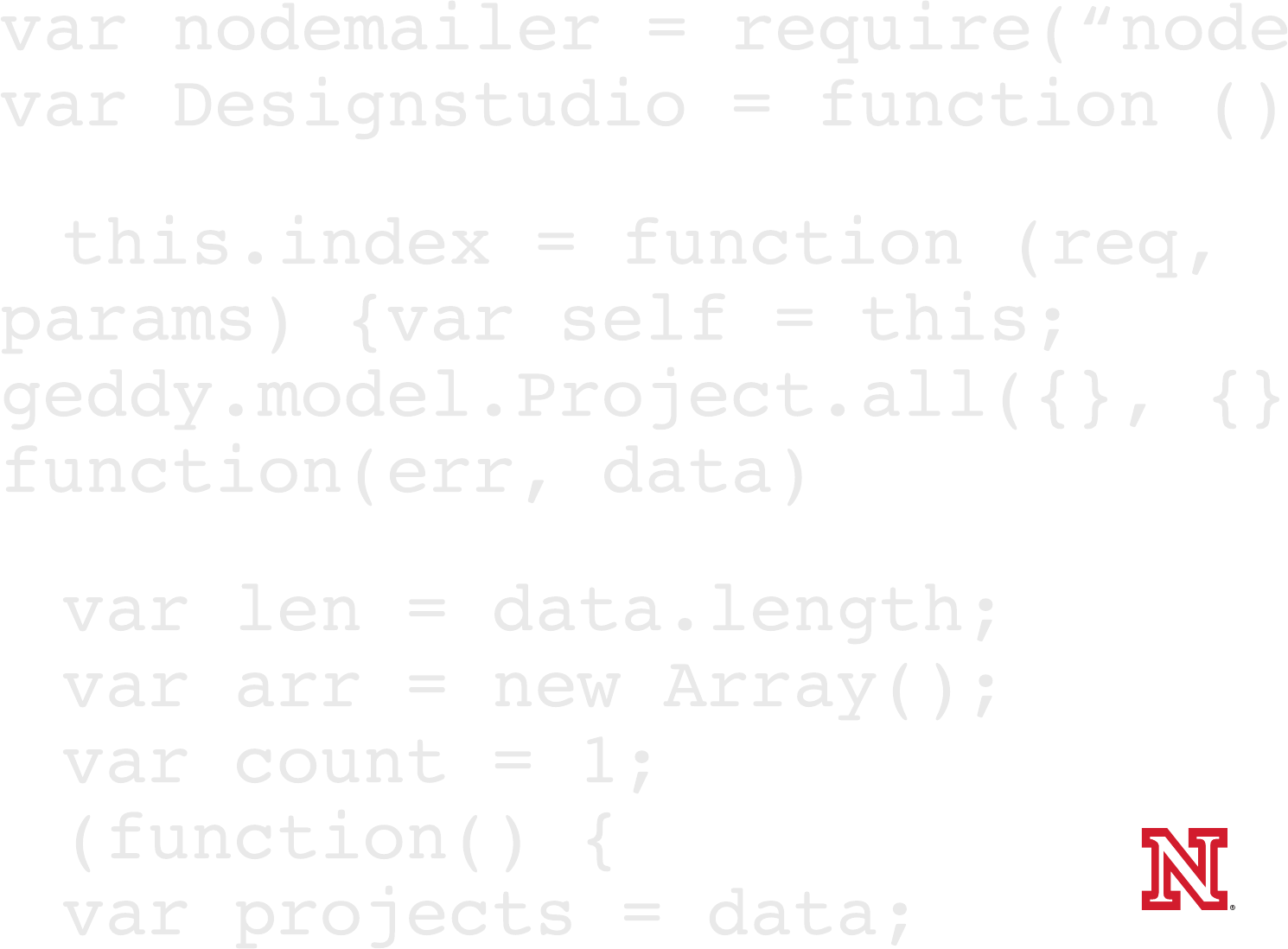
2013 - 2014 Project Report
Design Studio
Jerey S. Raikes School of Computer Science and Management
University of Nebraska–Lincoln
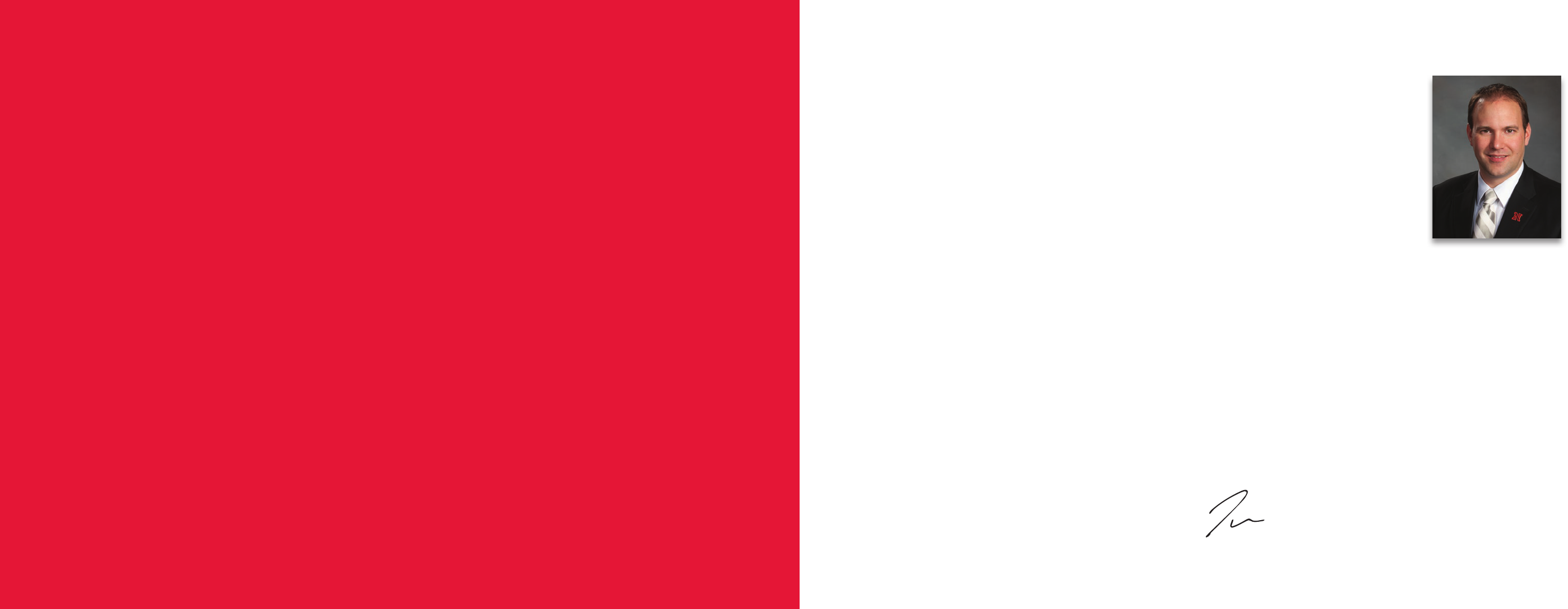
DS 13/14 I 1
Innovation is reshaping Lincoln. is can be seen in a very real way in the historic Haymarket.
Buildings that a century ago warehoused the commodities of the day are now storehouses of
innovation lled with new technology startups that have an ever-increasing demand for talent.
Our graduating students have the opportunity to nd jobs here that once could only be found
in Silicon Valley. Just a few blocks away, University of Nebraska researchers are continuing to
engage with business across Nebraska and the nation to bring to market cutting edge solutions
to wicked problems. Activity is everywhere, innovative minds are doing amazing work, and the
students, faculty, and sta of Design Studio are delighted to be at the forefront of the action.
Whether it is working with a student startup to develop tools that help local merchants
better understand their customers or developing robust enterprise workow for a Fortune
10 company, Design Studio is riding the wave of innovation, pushing the limits of what is
possible when industry connects with academia. is year, 67 of the brightest minds on
campus have been working with industry partners to:
• Improve the way patients navigate hospitals to help them more easily locate needed
services and care providers
• Develop solutions for local merchants to better connect with and understand
their customers
• Create mobile tools for property buyers to better manage the process of obtaining a loan
• Streamline the process of requesting pricing for transportation costs
• Gameify learning about new products to better engage insurance agents in promoting
new options to their clients
• Invent new ways to eortlessly capture athlete video to deliver important feedback
at practice
• Transform the way workow approvals are accomplished in business environments
• Bring the power of Hudl video to the Mac
• Reduce the number of hours a nancial institution spends reconciling payments
• Rethink a successful gaming platform to position it for small-screen play
• Connect auto hobbyists with experts to create a community for supporting projects
• Help researchers studying human tracking to more easily nd relevant data from
organizations on the ground in the tracking hotspots
• Deliver hundreds of gigabytes of photographs with highly-relevant
environmental data on mobile devices
It seems hard to believe that in just a few short weeks another year will come to a close and
teams in Design Studio will be handing o the innovative products and solutions they have
developed over the last year. To say that the students in Design Studio rose to the challenge
would be an understatement—they delivered soware products that hold their own against
those of any seasoned professional development team.
As I come to the close of my second year in my role
in Design Studio, I continue to be blown away by the
remarkable solutions that students in Design Studio are
able to conceive of and then execute.
So much of the success that you will read about in this
annual report would not have been possible without the
support of our industry partners. Partners who sponsor
projects, donate employee time to coach teams and
mentor students, and support the eorts of the Raikes
School to build a better community in Nebraska through
innovation and educational excellence. is year we are
recognizing in a special way the extraordinary support
of two of our partners: Mutual of Omaha is completing
its 10th project in Design Studio, and Assurity Life and Casualty is completing its 5th.
Organizational partners like these make what happens in Design Studio possible. All of
our partners are making a dierence every day in the lives of our students and all of us at
the Raikes School are deeply grateful for their support.
As the semester draws to a close and students head to summer internships and new careers,
we are already thinking about what comes next. e technology industry never stands still,
and neither does the Raikes School. Design Studio faculty and sta are continuing to nd
ways to engage colleagues on campus, promote excellence in research and education, create
new opportunities for more students, and leverage the power of academic excellence to help
create a better community.
No matter the success we have seen in the past, in the Raikes School we are always looking
forward. Rethinking our academic and educational models, devising new and innovative
ways to develop the leaders of tomorrow. Ours is a model that just over a decade ago was
radical and unproven. Today, it is a model that we may better understand but one that is
continuing to evolve. Because of that evolution, what one can observe in Design Studio is the
Raikes School model for innovation, for education, and for industry engagement … a model
for the future!
Ian J. Cottingham
Associate Director for Design Studio
A Model for Success
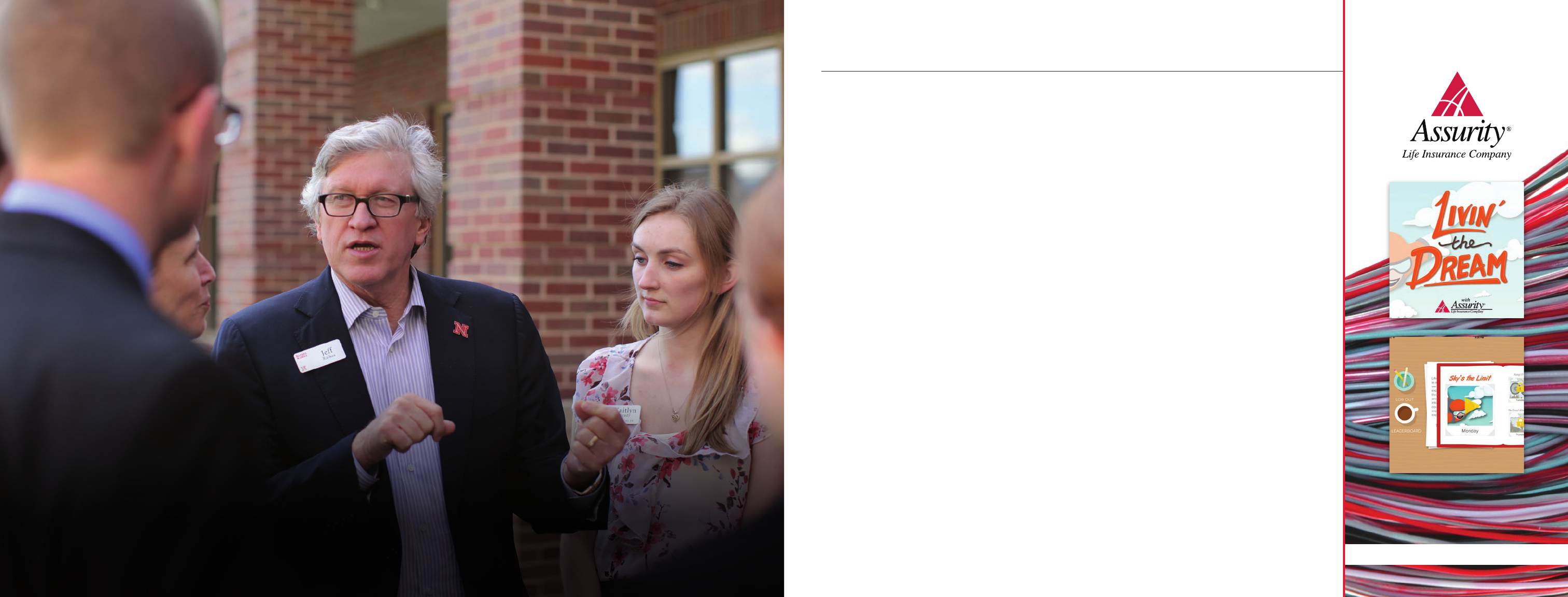
DS 13/14 I 3
“I think the Raikes School means to business today the idea of amplifying
the power of information technology through the power of human capitol…
great people.”
Jeff Raikes, Raikes School Corporate Advisory Board
Project Sponsor
Assurity Life Insurance Company is a mutual insurance
organization licensed in 49 states and the District of Columbia.
At the end of 2013, the company reported $2.45 billion in assets.
Design Studio Team
Janelle Rickstrew (Second Year), Caitlin Bales (Second Year),
Lynnea Bush (First Year), Mitchell Markin (First Year), Tyler
Zubke (First Year)
The Challenge
When most people think of life insurance, they rarely think “fun.”
But Assurity aims to change that perception with its “Livin’ the
Dream” game application for its distributors (sales brokers).
e Design Studio team was challenged to create an iOS game
application that educates distributors about Assurity products in
a fun and competitive atmosphere. Distributors can sell products
from a variety of vendors, so it’s key for Assurity to educate
brokers on its products, heighten brand awareness and foster
some good, old-fashioned competition among distributors at
the same time.
e “Livin’ the Dream” application consists of ve games that
engage users with “bucket list” activities, such as sky diving,
deep-sea shing and zip-lining. ere is also a testing component
that requires users to answer questions about Assurity products
throughout the day to continue game play. For Assurity
distributors, points earned from the questions and games will
count toward their standings in ongoing company contests,
which they can track as part of the application.
Assurity’s goal was to promote itself to brokers and bolster its
reputation as a forward-thinking company. For Assurity, the
Design Studio project was an opportunity to forge ahead into
a previously uncharted territory—the iOS environment for
use on iPhones and iPads.
It was a new frontier for the students on the team, as well.
“None of the students had experience with the iOS platform,”
said Product Manager Janelle Rickstrew. But she praised her
team for embracing the challenge by learning how to develop
in XCode with the Sprite Kit Framework.
Assurity Senior Business Analyst Britton Bailey agreed team
members exceeded expectations for the project and commended
the team’s professional approach.
“ey were dedicated to succeeding with us from the start,” he
said. “e team not only delivered on schedule but kept ahead
of our very aggressive project and timelines.”
Development Manager Caitlin Bales welcomed the challenges
that arose in Design Studio.
“I have gotten to work with a lot of new technologies and
experiment with things I otherwise wouldn’t have the
opportunity to,” she said. “I really enjoyed working with
clients and getting to participate in the design iteration process.”
Rickstrew was proud of her team’s initiative.
“We developed not only one game, but ve!” she said. “e
ambitions of our client at the beginning of the school year did
leave us with a large workload and little experience, but my team
learned quickly and worked hard to exceed client expectations.”
Project: Livin’ the Dream

4 I DS 13/14 DS 13/14 I 5
Project Sponsor
Conteneo, a California-based company that created “Knowsy.”
Knowsy is a patent-pending social game that doubles as a
research tool, collecting consumer input on topics and products.
Design Studio Team
James Verhoe (Second Year), Alex Scheideler (Second Year),
Blake Adams (First Year), Daniel Baylog (Second Year), Derek
Christensen (Second Year), Keegan Jorgenson (First Year)
The Challenge
Few can resist the pull of “Knowsy,” an online gaming sensation
that tests users on how well they know their friends, family
members and co-workers. e allure of quizzing your friends on
their likes and dislikes makes for an irresistible parlor game on
your desktop computer.
But behind all the giggles and gasps that come with guessing
what’s on fellow gamers’ minds, there is serious research going on.
Under the guise of “play,” Knowsy is a stealth consumer research
tool that helps companies better understand their customers.
Yahoo!, HP and other companies have used Knowsy to gather
information on preferences from customers and employees.
Despite its wild popularity, the game is available on a website
made only for desktop and tablet computers. at’s where the
Design Studio team led by James Verhoe comes in. e team
was assigned to redesign the desktop and tablet game for use on
a smartphone. e goal was to give smartphone users the same
feel and functionality of the Knowsy application they love, while
expanding Conteneo’s range of compatible devices and customers.
e Design Studio team also built a framework for user-generated
content that will create opportunities for Conteneo to broaden the
use of its platform. For example, companies will collect better data
by allowing players to submit items in the middle of the game.
Customers, too, will benet from customizing their Knowsy to
play with friends.
Team member Keegan Jorgensen enjoyed the multi-tasking that
resulted from producing the app.
“My jobs varied greatly between releases,” he said. “I learned new
skills, such as writing and testing business models, conceptual and
coded data modeling, and varieties of user testing.”
Working on a team project with a fast turnaround was icing on
the cake for Jorgensen.
“Working with friends on a real project was my favorite part
of Design Studio,” he said. “e fact that this app will be in
the hands of customers a few months aer our completion is
pretty cool.”
As product manager, Verhoe played his own, real-life game of
“knowsy,” as he learned about his teammates’ preferences and
work styles.
“Team dynamics are critical to a project’s success,” he said.
“Culture and vision are important to motivating the team ...
Vision needs to be shared … Without these team dynamics, even
a great project with highly skilled team members will not get
as far as a team with incredible team dynamics. Design Studio
helped me understand how development teams work, which is
incredibly valuable as I move forward as an entrepreneur.”
Project: Conteneo Knowsy
Project Sponsor
Hudl, a Lincoln-based start-up company founded by three Raikes
School graduates. Hudl provides fast-paced and exible video
solutions to help athletes and teams improve performance and
game play.
Design Studio Team
Brian Grieb (Second Year), John Hotovy (Second Year), Steve
Dosskey (First Year), Dan Drews (First Year), Jesse Epperson
(First Year), Andrew Filippini (First Year)
The Challenge
Lincoln-based tech startup Hudl has already built a national
reputation among the 15,000 college and high schools that use its
innovative video playback soware to prep for “e Big Game.”
More than 300,000 coaches and 1 million athletes login to Hudl
each fall to improve team performance in football and basketball.
Hudl’s not a company that is content with the status quo, though,
so the rm partnered with a team of Design Studio students to
devise an application that benets athletes and coaches in more
individualized sports.
Hudl gave free rein to the Design Studio team to choose a sport
and develop a way to add value to practice. e team settled
on diving and the ever-evolving project took shape as an iPad
application for coaches. e iPad is placed on a tripod facing
the board and automatically records each dive—using advanced
video analysis and motion sensing—without wasted video
between dives and without someone starting and stopping
the camera.
is simple function records every dive and frees up coaches
from mundane videotaping to instruct athletes during practice.
e application also includes a suite of tools that includes slow-
motion, frame-by-frame analysis and drawing tools to manipulate
the recorded clips. Although this particular project focused on
diving, some of the application’s functions can add value to other
sports where technique is key, e.g. pole vaulting.
Hudl Project Manager Andrew Brinkman couldn’t be more pleased
with the research of the “top-notch” Design Studio team.
“We’re really intrigued by the possibility of a ‘set it and forget it’
video solution for individual sports practice, and the team is on
a great path toward delivering that vision,” Brinkman said. “e
team is full of incredibly talented developers, and they’re also
very well organized. … ey’ve really taken the initiative in user
interviews and user testing of their app.”
Product Manager Brian Grieb is grateful for the real-world
experience that Design Studio provided, and he particularly
enjoyed the client and the subject matter.
“We had a great client, and it was unique to experience the culture
of the company and have the opportunity to feel like we were
employees,” he said. “e most exciting part was the opportunity
to attend multiple sport practices and do research and user testing
as a team. … I know I speak for the team when I say we were all
excited and thankful for the opportunity.”
Project: Hudl Individual Sports Practice Assistant
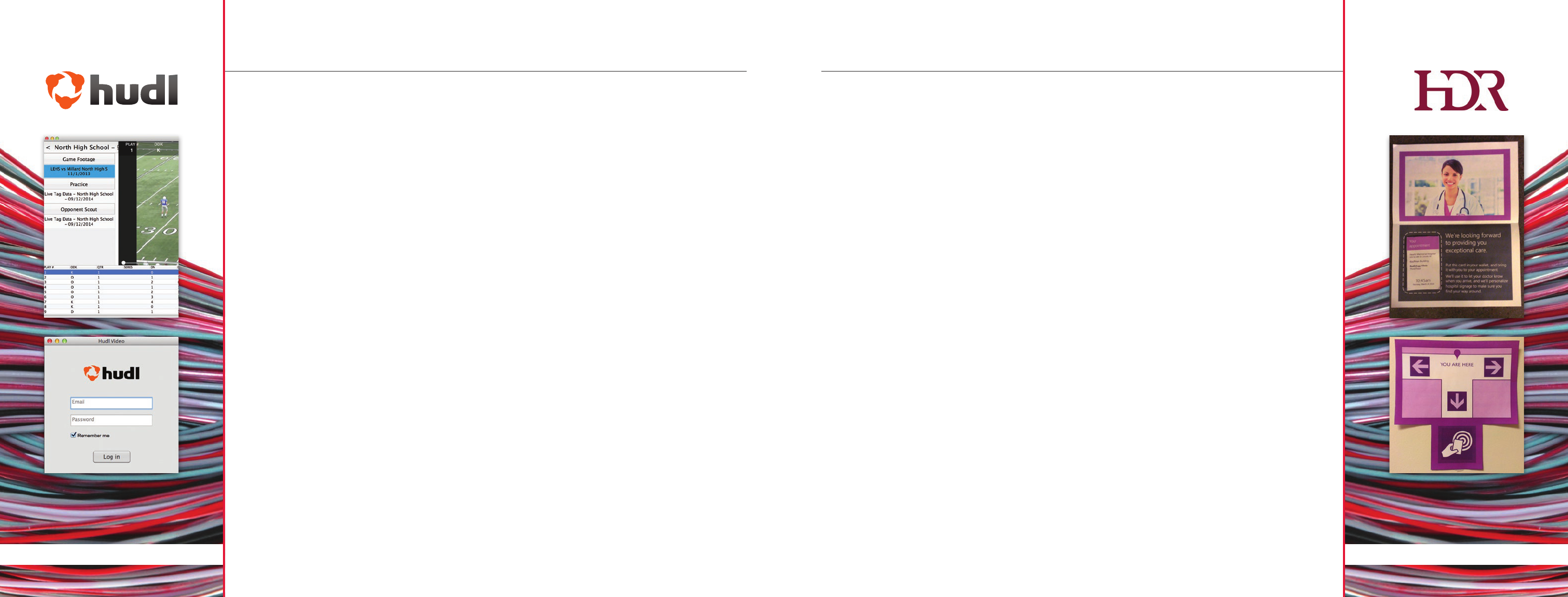
6 I DS 13/14 DS 13/14 I 7
Project Sponsor
Hudl, a Lincoln-based start-up company founded by three Raikes
School graduates. Hudl provides fast-paced and exible video
solutions to help athletes and teams improve performance and
game play.
Design Studio Team
Nathan Allgood (Second Year), Danny Eberly (Second Year),
Chase Blazek (First Year), Brandon Collins (First Year), Andrea
Uher (First Year)
The Challenge
Hudl wanted to capitalize on its success in video playback
soware for coaches and teams by going the extra mile with an
application for Mac operating systems. Besides a tablet computer,
there wasn’t a convenient way for coaches to view video oine.
e Design Studio team’s goal was to create an “intuitive,
engaging and buttery smooth” process for coaches to watch
videos with or without an Internet connection, said Danny
Eberly, project development manager.
Mission accomplished—with a bonus. “Due to the excellent
frameworks already built into the Mac environment, our app
will give Hudl users an improved ability to analyze and watch
footage of their sports teams,” said team member Chase Blazek.
e Design Studio project presented learning opportunities in
coding, Mac application development, and priorities, Blazek said.
“We discovered early on in the year that we wouldn’t have enough
time to complete all the features we had initially set out to do. As
such, we needed to prioritize certain features, tasks and bug xes,”
he said.
at meant team members had to communicate and compromise
with one another and the client to dene the application’s
focus. Rening the essentials with team members and the client
contributed to “a product that the customer is going to be happy
to use,” said Blazek.
e project was win-win for both the Design Studio team and
Hudl, said Faculty Advisor Jeremy Suing.
“e students actually had to build and manage the relationships
with these customers, manage product feedback and learn
the processes and skills required to make a ‘production-ready’
product,” he said. “For the client, the students provided customers
with a solution that ts better into their lifestyle and needs.”
Project: Hudl Mac OS X Video Application
Project Sponsor
HDR, a global employee-owned rm that provides architecture,
engineering, consulting, construction and related services. HDR
has worked on projects in all the states and 60 foreign countries.
Design Studio Team
David Stephens (Second Year), Patrick Jackman (Second Year),
Spencer Farley (First Year), Spencer Landis (First Year), Joe Lunde
(First Year), Kate Rilett (First Year), Michael Jensen (Intern)
The Challenge
Everyone knows what it’s like to be “lost” in a large building …
Roaming long hallways, retracing routes through corridors …
milling through crowds to get to some location without really
knowing where you are. Directories, signs and building maps
help, but they’re far from foolproof.
Designing more hospital space than any rm in the world,
Omaha-based HDR understands the need for a guidance system
that ensures patients and visitors can easily nd their way in
hospital settings. is modern concept of indoor navigation
has a name inspired by those who crossed the seas centuries
ago—“waynding.”
In architecture, waynding, in part, refers to architectural and
design elements that aid orientation and navigation in large
facilities. It’s an age-old problem with implications on the bottom
line. Every year, hospitals spend hundreds of thousands of
dollars to help lost patients and visitors. HDR wanted to
develop concepts for a user-friendly device that could guide
people who are unfamiliar with an environment to get to their
chosen destination.
Led by senior David Stephens, the Design Studio team was asked
to create hospital-navigation prototypes that improve the patient
experience. Waynding is a complicated concept, and creating a
family of wall- and ceiling-mounted waynding devices, driven
by patient identity for easy use in a hospital is not easily solved in
a school year.
None of the team had worked on an open-ended, hardware-
oriented design team before, so the project—the rst of its kind
for the Raikes School—focused on testing concepts and models to
determine what might work, and, just as important what won’t.
e Design Studio team’s research is valuable on many levels, said
Stephens. “In the short term, the ideas from our Design Studio
team can be presented by HDR designers to its management and
clients as examples of the company’s commitment to innovation.”
Team member Spencer Landis agreed. “While we may not nd
the perfect solution, we will have provided HDR with a lot of
important work and research to help the company get closer
to a better waynding solution,” he said. “is project could be
extremely useful if we are successful.”
Stephens credited the project’s knack for fostering professional
and personal creativity in team members. “It has been so rewarding
to watch our team bond and to watch everyone grow as designers,”
he said. “Besides that, it has taught me more about hospital
navigation than anyone has a right to know, which will likely
inuence my thinking in all sorts of interesting ways in the future.”
Project: HDR Wayfinding
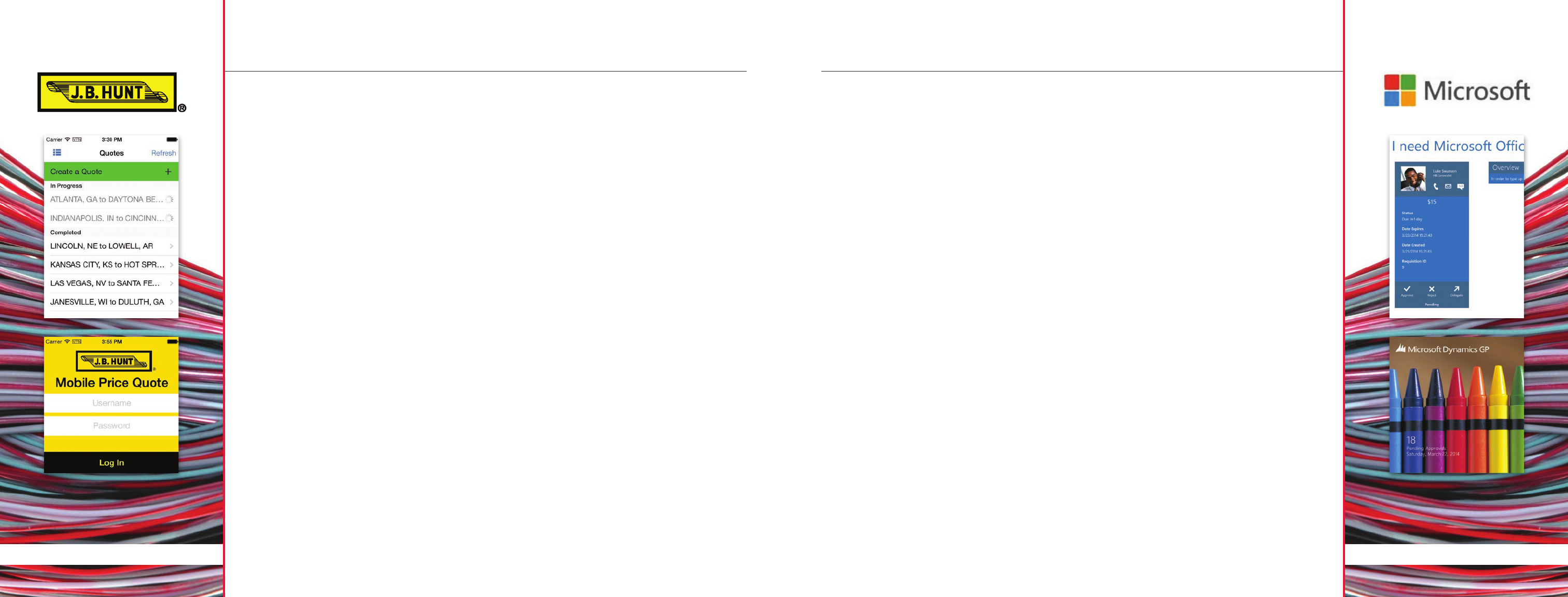
8 I DS 13/14 DS 13/14 I 9
Project Sponsor
J.B Hunt is a Fortune 500 company and one of the largest
transportation logistics companies in North America. It is
headquartered in Lowell, Arkansas.
Design Studio Team
Taylor Smith (Second Year), Davis Goodin (First Year), Kaleb
Anderson (First Year), Alex Koehler (First Year), Mathew Reny
(First Year)
The Challenge
As a North American leader in transportation logistics and
trucking, J.B. Hunt wanted to move its sales quote system into the
fast lane. e company has previously used a centralized Request
For Pricing (RFP) model that required sales people to wait for
data from the home oce before issuing a bid to the customer.
e company challenged the Design Studio team led by Taylor
Smith to create a mobile application to pull shipping rates on
demand via employee iPhones and iPads. e iOS app would
benet some 350 sales people and 75 pricing managers in the
eld, who need to respond quickly to customer inquiries.
J.B. Hunt estimates the mobile application will increase
revenue by $2.4 million a year in sales and improve customer
relationships. e app also will increase internal eciency when
pricing managers and directors discuss rates. Pricing sta will
receive information about rates and shipping lanes based on
conversations that were previously unavailable to them.
Faculty Adviser Ashu Guru said the team immersed itself in the
industry to understand the workow processes of issuing quotes
and the research paid o with a solution to increase customer
satisfaction and eciency.
“e team learned the intricacies of the system that is involved in
creating price quotes,” he said. “is gave the team an opportunity
to rapidly adapt in a complex environment and design and deliver
a solution to t (J.B. Hunt’s) needs.”
Smith enjoyed working with a client that gave her team a “long
leash” to be creative in devising solutions. “e creative freedom
was very exciting,” she said. She also enjoyed the experimentation
that came with iOS development, which was new to all members
of the team. “While learning a new language can be daunting, the
challenge was exciting for her and her teammates,” she said.
“I’ve been lucky to have the opportunity to take on the role of
product manager for my team, which has given me experience
in working and communicating with clients, task management
responsibilities, and overall leadership of a project,” she said.
“Seeing all of our hard work from previous classes come into action
has denitely been the most valuable aspect of Design Studio.”
Team Development Manager Davis Goodin echoed Smith’s
sentiments. He valued the development challenges, teamwork
and real-world applications of the Design Studio experience.
“My favorite part of the project is that for us, (the development
practices) have worked,” he said. “And we’re building an app that
I can be proud of.”
Mary Burke, J.B. Hunt logistics engineer, is also pleased with the
team’s work.
“e students were very creative and attentive to details,” she said.
“ey came up with several good suggestions for the application
and did an excellent job of communicating throughout the project.”
Project: J.B. Hunt Mobile Price Quote
Project Sponsor
Microso, an American multinational company headquartered
in Redmond, Washington. It is the world’s largest soware maker
measured by revenues.
Design Studio Team
Andrew Gaspar (Second Year), Keaton Greve (Second Year),
Claire Carlson (First Year), Nicholas Niday (First Year), Noah
Swartz (First Year), Derek Tiggelaar (Second Year)
The Challenge
As the market leader in oce soware, Microso has built its
reputation on serving the needs of countless managers and
supervisors. In the dynamic world of technology, the company
is always looking for new and improved ways to make work—
and life—easier for its users.
Enter Microso Dynamics GP Workow Approvals, an application
for Windows 8 that enables users to manage workow requests
for a company. Workow management systems ensure that all the
processes and procedures to accomplish a task are completed in the
correct order. It’s the high-tech way to manage a virtual “assembly
line” of processes that occur daily in the business world, e.g.
approving requisitions, timecards or vacation requests.
Microso Dynamics GP gives small and mid-sized businesses
control over nances, resources and decision-dening
information, while giving employees everything needed to
perform their best.
e Design Studio team, led by Andrew Gaspar, created a mobile
application for tablets to manage Dynamics GP Workow
Approvals so managers can respond quickly to outstanding
requests for company resources. e convenience of accessing
workow information instantaneously means managers, or
“authorizers” can approve, deny or delegate requests from
anywhere at any time.
Gaspar liked the practical implications and benets of creating
the Workow Approvals app.
“I enjoyed working with clients to solve real problems that they
face in their business or their product line,” he said. “What excites
me is that feeling of contributing value to a company while still in
school and the experience that comes with it.”
Development Manager Keaton Greve said it was dicult to design
a high-functioning, visually appealing and user-friendly interface,
but the experience was worth it.
“It was challenging to design an interface that worked well and
made sense to customers,” he said. “But with the popularity of
smartphones and tablets, designing a Windows 8 app is a very
modern skill that will be useful in my career.”
Project: Microsoft Dynamics Workflow Approvals

10 I DS 13/14 DS 13/14 I 11
Project Sponsor
CondoCerts, a Mutual of Omaha Bank Company, is a leading
Web-based data and document delivery system in the community
association industry. CondoCerts provides soware solutions
to management companies and community associations for
property sales across the country.
Design Studio Team
Trang Do (Second Year), David Dropinski (First Year),
Sarah Fanning (First Year), Tom McClenahan (First Year),
Travis Schreier (Second Year), Caleb Zatorski (Intern)
The Challenge
It takes a village … to manage a village. As anyone who has
belonged to one of the 300,000 homeowners’ associations in
America knows, there are lots of people who need access to lots of
information – FAST. Lenders, mortgage bankers, title companies,
real estate agents, homeowners and potential home-buyers need
round-the-clock access to documents and data to close a deal,
manage property or renance a loan.
CondoCerts, a Mutual of Omaha Bank Company, has been a
leader in supplying this data for years, but the company needed a
mobile application to fast-track the data to folks in the eld and
keep ahead of the competition. Enter the Design Studio team
led by Product Manager Trang Do, who oversaw the revision of
CondoCert’s Web application for an iOS environment for use on
iPads and iPhones.
e CondoCerts mobile app marked Mutual of Omaha Bank’s
rst ocial venture into the iOS mobile platform, said Do. With
it, the Mutual of Omaha Bank will have the “rst to market”
solution in the industry.
“(e mobile app) simplies the process of checking the status of
your document order and enables users to access their purchased
documents on the go,” said Do, who has enjoyed her second year
in Design Studio.
“I’ve had the opportunity to see what it’s like to have a developer
role on the team, as well as a manager role, both of which have
granted me invaluable skills and experience,” she said. e most
signicant challenge for her team, she said, was communication
with the client. “We really had to step up to set the standard of
communication we needed to make this project a success.”
Faculty Adviser Ashu Guru called the CondoCerts mobile
application a “unique opportunity” to enhance students’
“understanding of design and functionality” in a multi-layer
application between a customer’s mobile device and a Web-based
server. e project also gave students invaluable experience with
several project management and collaboration tools that they
will likely use as they graduate and move into professional roles
in industry.
Project: CondoCerts Mobile App
Project Sponsor
Nelnet Business Solutions, a provider of nancial services
products for more than 6,000 educational institutions in the
United States. Most products support payment processing
and reconciliation for schools in both the K-12 and higher
education markets.
Design Studio Team
Adam Prusa (Second Year), Mitch Snyder (Second Year),
Stosh Getzfrid (Second Year), Kevin Mahlin (First Year),
Andrew Tarr (First Year)
The Challenge
As the leading provider of nancial services products for
educational institutions, Nelnet Business Solutions is always
looking for a better way to do things. With a 30-year history as
an industry leader, Nelnet’s services and processes have evolved
to meet the needs of a huge and ever-evolving list of clients.
Every month, Nelnet’s accounting team spends hours reconciling
payments that clients have collected using Nelnet’s QuikPAY
product. QuikPAY has been customized for individual client
needs over the years, which resulted in a time-consuming process
for the Nelnet accountants tasked with monthly and/or daily
reconciliations. e current reconciliation process is functional,
but labor-intensive, slow and subject to human error.
So the Raikes School Design Studio team was challenged to create
a solution that consolidated a complicated mix of individual client
systems and platforms to streamline QuikPAY reconciliations for
the accounting team. e team, led by Adam Prusa, needed to
consolidate information from 20 sources to simplify the monthly
reconciliation of data.
e team originally considered building a website from scratch,
but decided instead to adapt a commercial product—PowerPivot
in Excel.
e project will signicantly reduce the time it takes to reconcile
the books and safeguard against opportunities for error, Prusa said.
Bonus: Making all that nancial information more accessible will
likely be useful to Nelnet for future data-mining opportunities.
A process that formerly took 1 to 2 hours a day and another 8 to
10 hours at the end of the month now takes fewer than 10 hours
in total each month to refresh the data to determine whether
further action is warranted. Team Development Manager Mitchell
Snyder estimated the process would save the accounting sta
around 500 hours annually.
e experience oered valuable lessons in understanding client
needs and problem-solving, Snyder said.
“Sometimes it’s best to take a step back and evaluate the reasons
for taking the approach you’ve chosen. Sometimes, the simpler,
more direct route provides a much better outcome,” he said,
“even if it means less coding.”
Prusa agreed. “It’s important to be open to change.”
Project: Nelnet Cross-Platform Reconciliation

12 I DS 13/14 DS 13/14 I 13
Project Sponsor
Pickit, a student start-up company that aims to raise money for
Lincoln-area nonprots with a merchant loyalty shopping app.
ree of the four student entrepreneurs behind the company are
Raikes School seniors.
Design Studio Team
Jerey Moran (Second Year), Josh Cox (Second Year), Asher
Chester (First Year), Zach Christensen (Second Year), Jedd
Patterson (First Year), Nate Watley (Second Year), Veronica
Telega (Intern)
The Challenge
A forgotten coupon was all it took. at little hassle spawned the
“Big Idea” for two Raikes School seniors in 2012.
en-sophomores James Verhoe and Zach Christensen were
tired of leaving coupons in cars and siing through wallets stued
with loyalty cards to save a few cents on fast food. ey thought
the world of discount marketing was archaic, so they hatched a
plan to create a mobile application for customers to get discounts
at participating merchants.
But why stop there? What if the new purchasing system also
enabled buyers to give back to their communities with donations
to favorite nonprots every time they used the app?
is multipurpose altruistic app – called Pickit – digitizes the
couponing world with a pay-per-redemption system that makes
every purchase a vote to support an area nonprot.
e start-up is new, and it needed help to build a foundation on
which to grow the business. Verhoe and Christensen enlisted
the talent of fellow Design Studio students to help build Pickit’s
infrastructure with a merchant portal and loyalty program
for shoppers.
e multi-function portal is critical to Pickit’s success, said
Product Manager Jerey Moran. With the portal, merchants
can register to participate; edit and create deals; sort and lter
redemptions; analyze customer data; and pay bills to area
nonprots online.
“Due to Pickit’s status as a new company, the work that we do will
directly impact Pickit’s bottom line and forward momentum,”
Moran said.
e second component of the project required the team to improve
the customer satisfaction by extending the Pickit experience to
provide more rewards and encourage more purchases.
e dual opportunity presented management and organizational
challenges that Moran and his team embraced.
“Design Studio is very fast-paced, and there are a lot of moving
parts. Each team member contributes a large amount of code and
thought, so it’s important that we all move in the same direction
to maximize the benet of what we deliver,” he said.
Witnessing other Design Studio projects evolve was also benecial.
“Being able to see a variety of projects develop over time with
changing requirements, client relationships and team strengths
has been of great value to me. I learned from all the teams, not
just my own.”
Project: Pickit Merchant Portal and Loyalty Program
Project Sponsor
Speedway Motors, a Lincoln-based company that is the world’s
largest manufacturer, distributor and retailer of street rod and
racing products.
Design Studio Team
Sara Benning (Second Year), Justin Pueger (Second Year),
Michael Draz (First Year), Jake Heidelk (First Year), Jake Schmitt
(First Year)
The Challenge
As America’s oldest speed shop, Speedway Motors has been
a trusted source of support and expert advice for custom car
builders since 1952. Although Speedway’s exceptional customer
service never went out of style, the way it has been delivered
needed a tune-up.
Speedway Motors already hosts a telephone “help desk” for car
enthusiasts, but the company wanted to improve eciency and
service with the aid of technology. e Design Studio team was
challenged to create Android and iOS apps to connect custom car
builders to Speedway technicians and their knowledge base.
e app enables users to search a library of helpful articles and
review questions from other users. If the existing knowledge base
doesn’t have the answer, the user can submit the question (along
with photos and background data) to Speedway experts and other
community members for insight.
Armed with better information from the app, Speedway techs can
better address customer questions and direct them to a products
link page for parts, if necessary. e app also means Speedway
will pull ahead of its competitors in the mobile market.
Product Manager Sara Benning said the project built team
members’ skills in several areas: managing client expectations,
professional interaction, user testing, and building an app with
multiple mobile technologies.
Team member Jake Heidelk enjoyed his team and the creative
process involved with building the app.
“It is very apparent that what I’m working on will provide some
real value to Speedway,” he said. “Gaining experience with mobile
development has been an extremely valuable aspect of Design
Studio, especially given the ‘hotness’ of mobile programming
t o d a y.”
e project entailed building apps for both Android and iOS
platforms, which were herculean tasks, said Benning.
“Learning new technologies, especially Android, proved to be
dicult,” she said. “It was also challenging to build two dierent
apps concurrently, which fragmented our team and reduced
resources a sub-team had available when they needed extra help
on a feature.”
But the team overcame these issues—with a good sense of humor
intact.
“In the end, we triumphed,” Benning said. “And we are now the
smartest people in the room.”
Project: Speedway PocketMechanic App
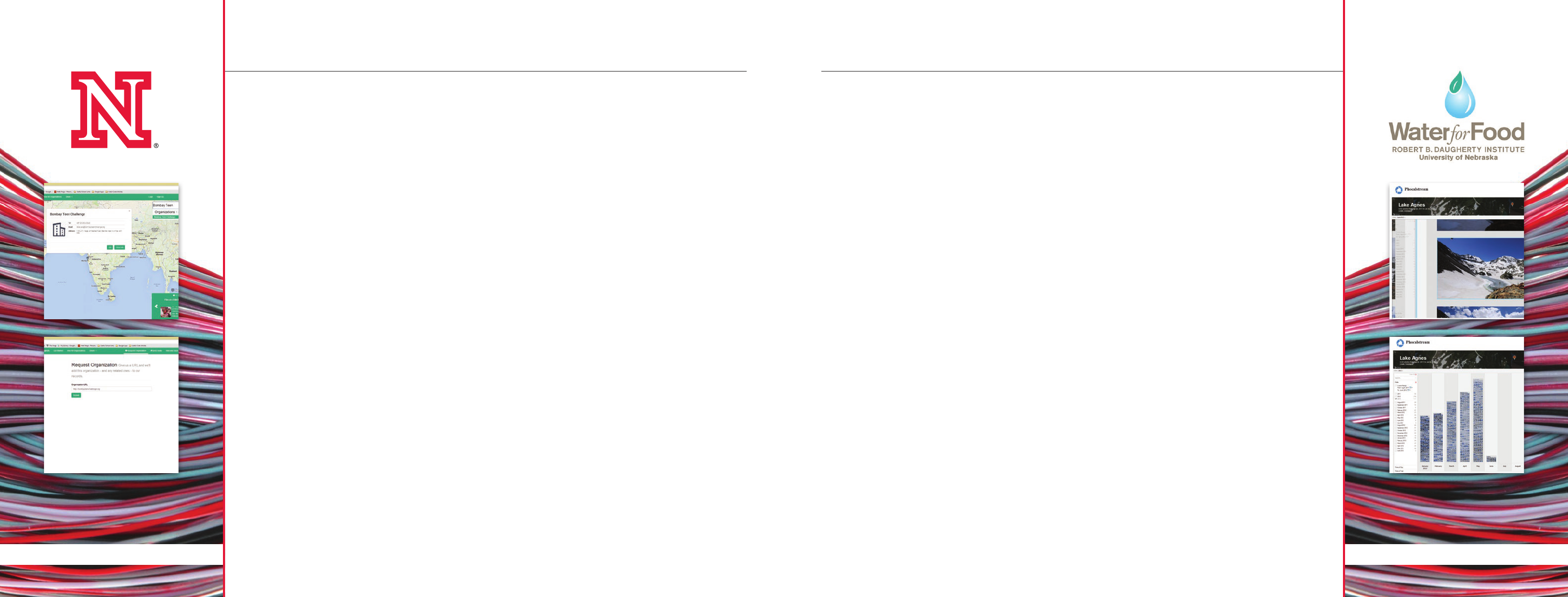
14 I DS 13/14 DS 13/14 I 15
Project Sponsor
University of Nebraska–Lincoln
Design Studio Team
Aubrey ompson (Second Year), Jordan Degner (Second Year),
Sam Adams (First Year), Cameron Crockrom (First Year), Paul
Poulsen (First Year), Brian Yee (First Year), Marcus Pasell (Intern)
The Challenge
Human tracking is tied with the illegal arms industry as the
second-largest and fastest-growing criminal industry in the world
(behind drug tracking). Some 600,000 to 900,000 people are
tracked across international borders each year for exploitation.
Staying ahead of those who trac other humans requires
signicant research; research that UNL faculty are leading the
way in conducting.
ere is a huge volume of information about tracking on
the Internet, but to date, there is no organized database for
researchers to nd the information eciently. is lack of
readily accessible, organized, timely and reliable data hinders
eective and ecient anti-tracking research eorts and makes
understanding and addressing activities all the more dicult.
e Design Studio team, led by Jordan Degner was assigned
to build a Web crawler that constantly scans the Internet for
information on anti-human-tracking eorts in India. Anti-
tracking groups in that country can then use this centralized
data source to prevent the crime, protect the victims and
prosecute the oenders.
Building a knowledge-management system from the ground up
was a monumental task due to the sheer volume of unorganized
information available, said Degner.
“It can be amazingly hard to tell a computer to do something
you do with your own eyes in seconds,” he said. “We overcame
that problem by revisiting it every release. We’re never done;
we’ll never be collecting perfect information. But we can—and
should—try as hard as we can to constantly improve the quality
of the information we nd.”
at commitment to quality pleased team member Sam Adams.
“I was surprised by the sophistication of the product we made
over the course of the year, especially with how well our Web
crawler worked on its own,” he said. “Coming into ‘team time,’
I looked forward to the excitement of what I could accomplish
each day, and how our team might use our strengths to move
forward on this project.”
e Design Studio experience has likely shaped Development
Manager Degner’s future. He’s now interested in development
management.
“is year’s project has shown me what I want to be doing in my
career, because I love what I’m doing right now so much,” he said.
“It’s an awesome feeling to know what each person on your team
does well. It’s an even better feeling to be able to delegate work in a
way that really lets everyone do what they love as much as possible.”
Project: UNL Anti-Human Trafficking Knowledge Database
Project Sponsor
Robert B. Daugherty Water for Food Institute
Design Studio Team
Tobin Brown (Intern), Wyatt Goodin (Intern),
Ashlyn Lee (Intern)
The Challenge
e Platte River and the ecosystem that it feeds is one of the most
signicant tributary systems in the watershed of the Missouri,
having a major impact on the ecology of Nebraska, Wyoming and
Colorado. In the face of global climate change, the Platte has seen
both record ooding and record drought in the past several years.
Understanding the impact of climate on both the river and the
surrounding environment is highly signicant in conservation
eorts, research and education.
No one understands this better than photographer Michael
Forsberg and television producer Michael Farrell, who have
been studying the Platte River by developing time-lapse
photographs of various sites along the Platte for the past
two years.
Having produced nearly 120,000 photos of the Platte that span
several camera sites along the river since 2011, Forsberg and
Farrell were looking for a better way to manage data. At the
same time, the Robert B. Daugherty Water for Food Institute
was looking for new and creative ways to study the Platte and
implement an educational tool for elementary school students
who will become the next generation of scientists.
In a follow-on Design Studio project, dedicated to on-campus
faculty research support, the Water for Food Institute, the Time-
Lapse Photography Project and Design Studio faculty partnered
to develop the next phase of an integrated photo system called
Phocalstream.
Incorporating the rich photoset from the time-lapse project
and data from the National Drought Mitigation Center and U.S.
Geological Survey, Phocalstream enables users to quickly search the
thousands of photos and incorporate historical Drought Monitor
and Stream Flow data. e result provides a holistic picture of
the impact of climate on the Platte River. e site helps students
visualize climate, discover data relationships, create their own time-
lapse videos, and share their observations of the natural world.
Using a robust data annotation framework, Phocalstream
engages students in crowdsourcing to catalog and analyze the
images produced by the time-lapse project. A major component
of work in Design Studio this year has been bringing the rich
photographic imagery found on the Web to mobile devices like
iPads, which enables user interaction with the vast image library
and opportunities to contribute their own images.
Of the rst-of-its-kind project, Raikes School Assistant
Professor of Practice and Associate Director for Design Studio
Ian Cottingham said the project is an invaluable exercise in
collaboration for the greater good.
“Phocalstream is about leveraging the power of research at the
university and harnessing the best and brightest minds to unlock
the imaginations of aspiring young scientists. As faculty, we have
the opportunity to work alongside our Design Studio students,
practicing what we teach, sharing in the experience of product
delivery, and providing mentorship for future Design Studio
classes,” Cottingham said. “I can’t imagine a better way to keep
learning than to roll up my sleeves and sling some code with
some of the most talented young developers out there.”
Project: Phocalstream
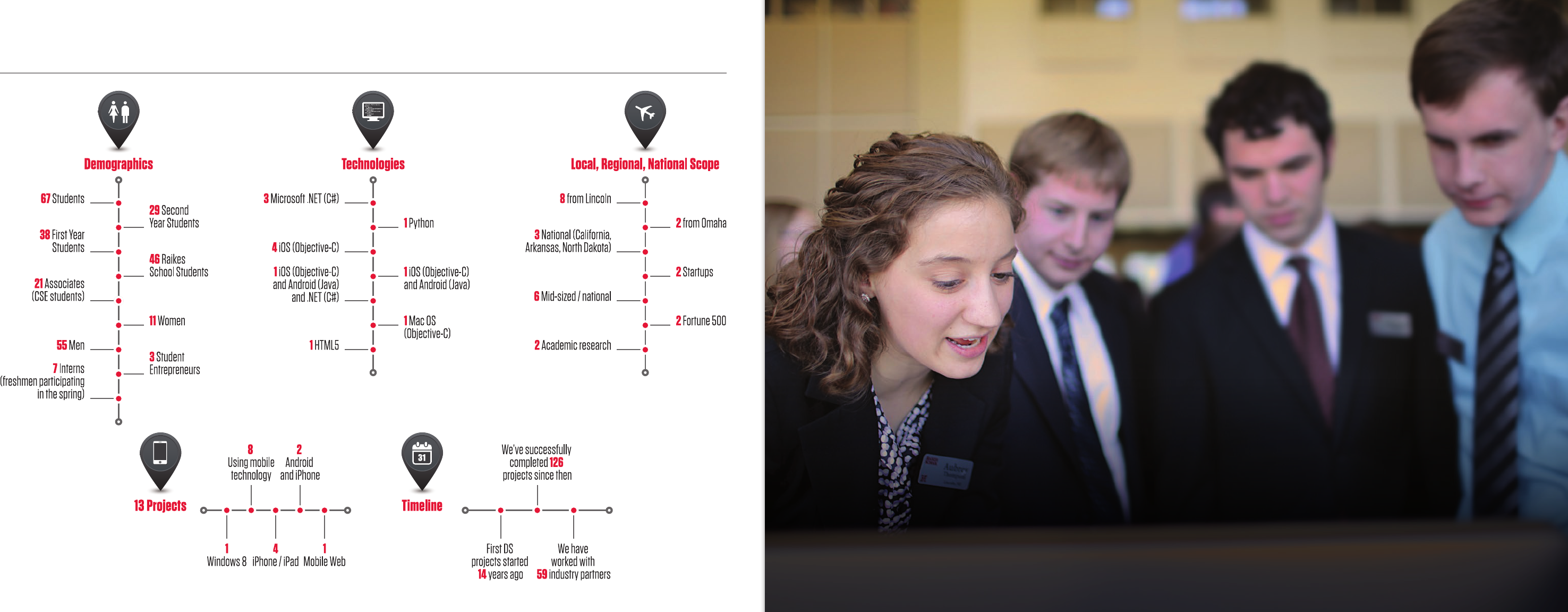
16 I DS 13/14
Stats
“The Raikes School really has it figured out, you learn the most when you
do. Rather than plan, talk and just focus on the theory of what we should do,
we actually do it. And that culminates in Design Studio. Your junior and senior
year you get to work all year long on a project for a client that they’re actually
going to use, that they actually have sales. And we get to do it.”
James Verhoeff, Raikes School Class of 2014
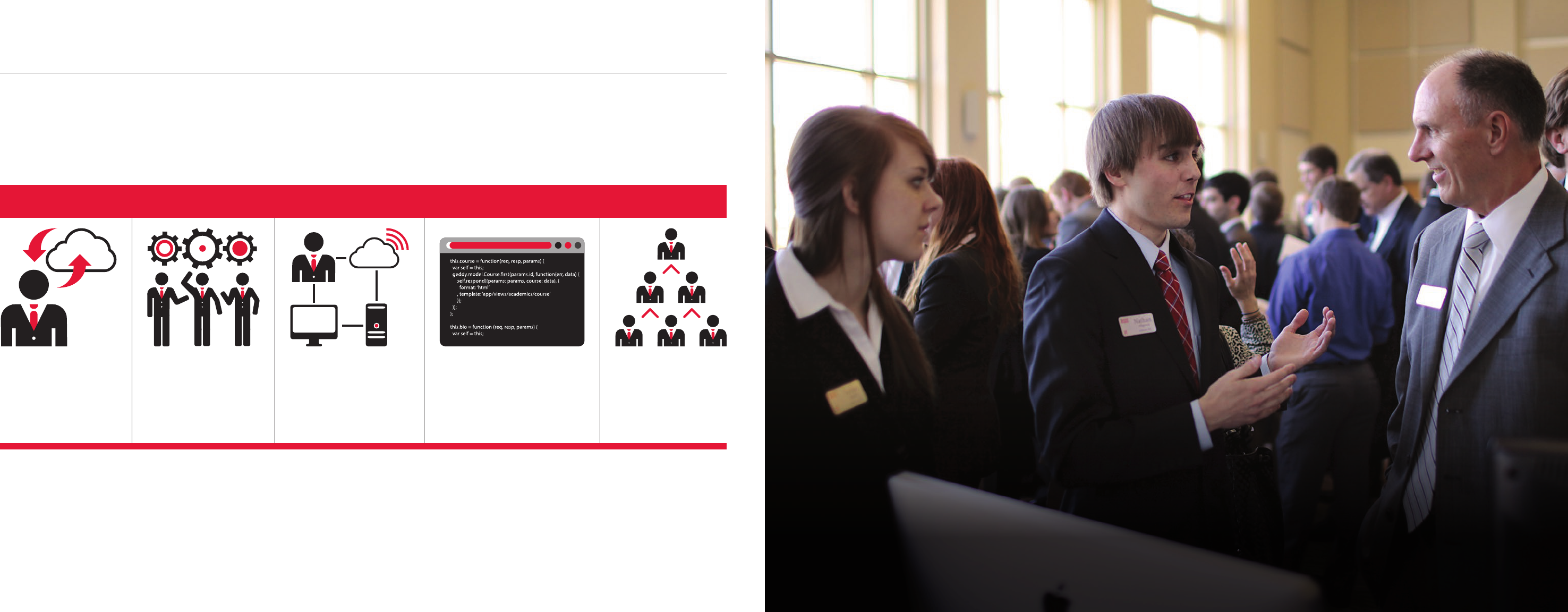
18 I DS 13/14
In Design Studio, we integrate Agile engineering processes, Lean business development,
and interdisciplinary design thinking into an iterative process for problem solving and
product development. Our iterative development methodologies lead to the development
of robust soware products that address real problems and provide elegant solutions.
roughout the process, Design Studio teams are mentored by industry professionals
from the community,
helping teams more eectively communicate, overcome technical
challenges, and drive
innovation for their partners.
How Design Studio Works
Understand the needs of
the user and WHY those
needs exist.
Think about ways to
address user needs in the
context of their problem.
Define a software
component that realizes the
idea and conceptualizes
the solution.
Code the problem
definition in order to see
the functional solution and
share it with the user.
Meet as a team to show
results, get feedback
and iterate.
Empathize Ideate Define Prototype Test
“Here’s the bottom line. Software is the magic that’s going to change the world.
It’s going to change every single industry. It’s the giant lever. Software is the
biggest extension of human thought ever. If you think in terms of improving
the productivity and enhancing the equality of life of humans on the planet…
software is the biggest extension of human capability ever over anything else.”
Doug Burgum, Raikes School Corporate Advisory Board
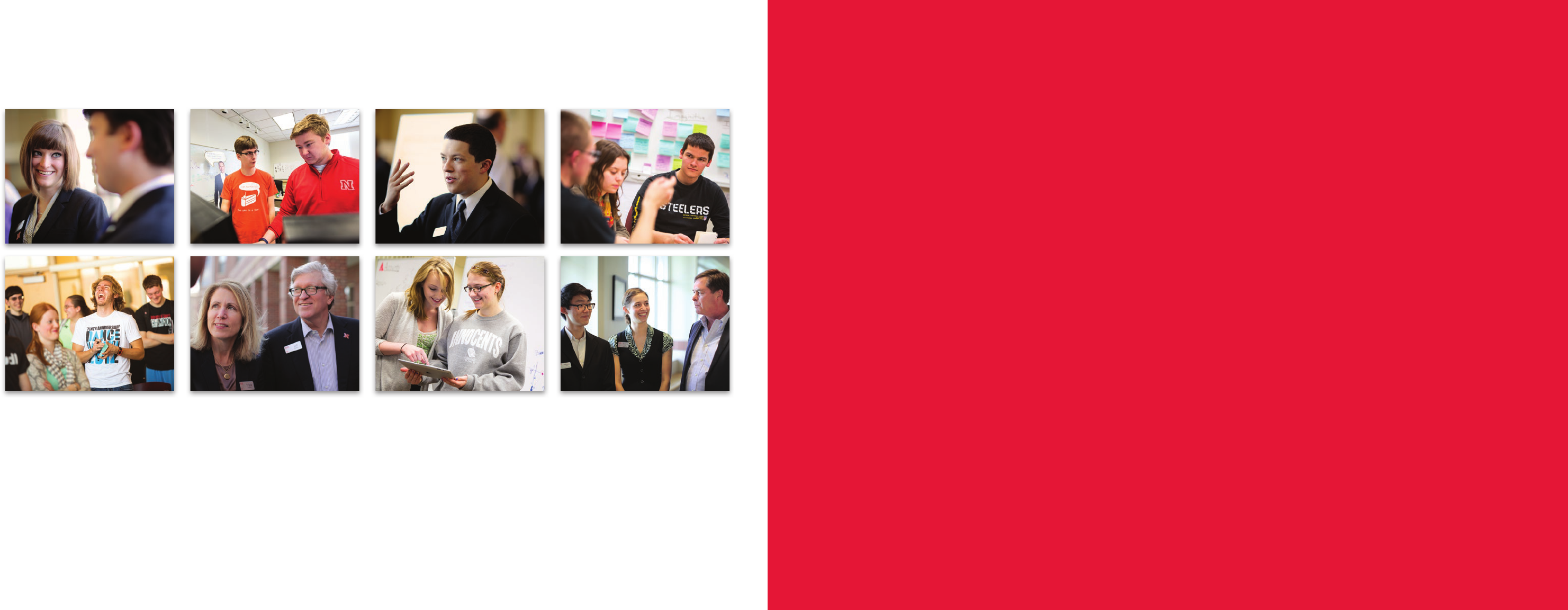
20 I DS 13/14
The Design Studio Team
Ian Cottingham, Associate Director for Design Studio, [email protected] I Jeremy Suing, Design Studio Project Manager, [email protected]
Ashu Guru, Design Studio Director of Research Strategy, [email protected] I Doug Durham, Adjunct Associate Professor
Tom Seevers, IBM Fellow and Visiting Professor I Amanda Leingang, Administrative Coordinator, [email protected]
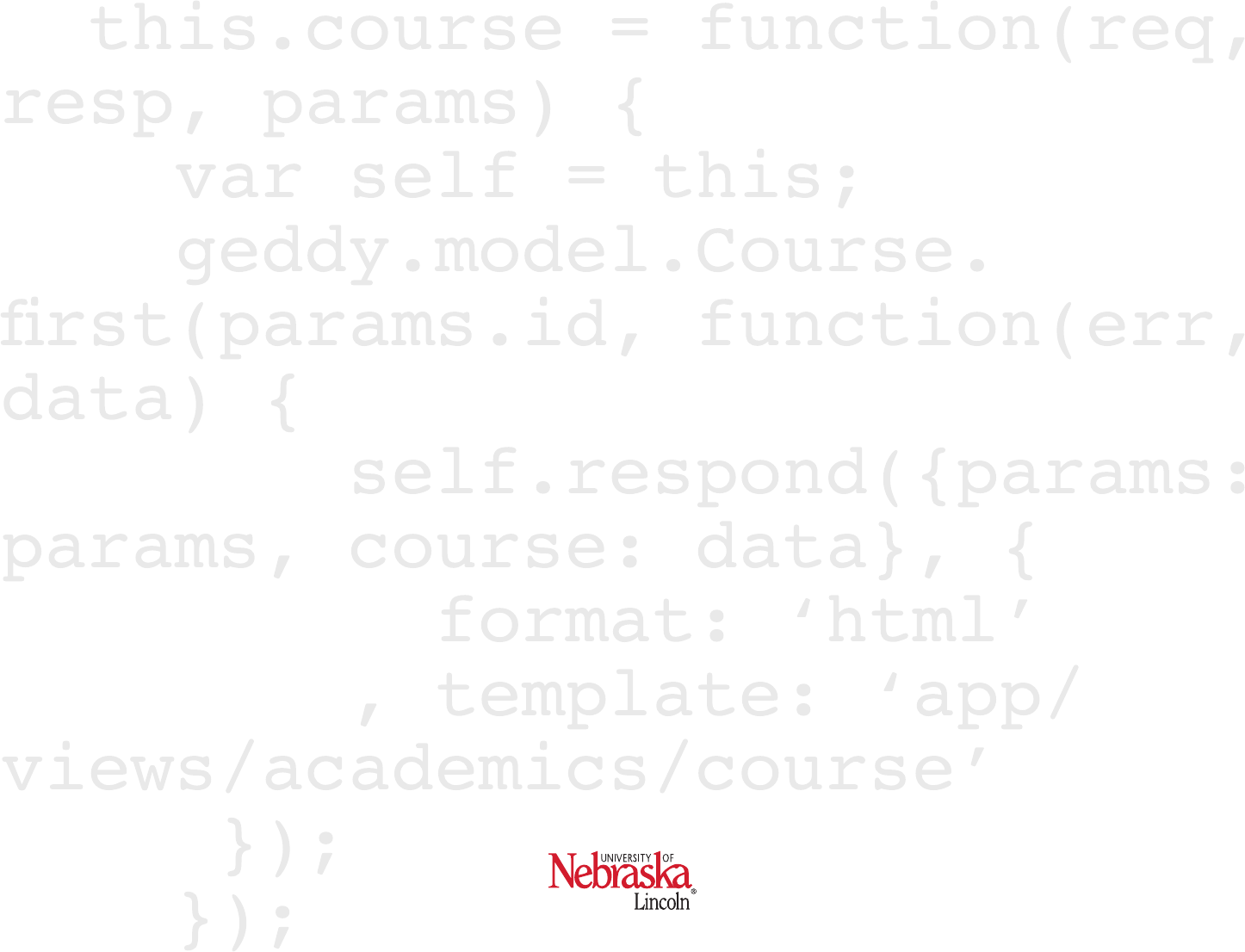
The University of Nebraska–Lincoln is an equal opportunity educator and employer. ©2014, The Board of Regents of the University of Nebraska. All rights reserved.
raikes.unl.edu
